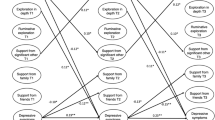Abstract
The self-concerns and social expectations that are part of the identity development process may lead adolescents to think that others survey them for signs of individuality. The novelty of identity development may also lead to feelings of uniqueness and invulnerability. The imaginary audience and personal fable may therefore stem from identity development and not from the emergence of formal operations. In this study high school and first-year university students (N=255) completed measures of adolescent egocentrism, identity development, and formal operations. Egocentrism was moderately associated with higher scores on identity crisis and identity achievement, and with lower scores on identity diffusion. There was no significant relationship between egocentrism and the emergence of formal operations.
Similar content being viewed by others
References
Adams, G. R., Abraham, K. G., and Markstrom, C. A. (1987). The relations among identity development, self-consciousness, and self-focusing during middle and late adolescence.Dev. Psychol. 23: 292–297.
Bourne, E. (1978). The state of research on ego identity: A review and appraisal, Part II.J. Youth Adoles. 7: 371–392.
Cohn, L. D., Millstein, S. G., Irwin, C. E., Adler, N. E., Kegeles, S. M., Dolcini, P., and Stone, G. (1988). A comparison of two measures of adolescent egocentrism.J. Pers. Assess. 52: 212–222.
Côté, J. E., and Levine, C. (1988). A critical examination of the ego identity status paradigm.Dev. Rev. 8: 147–184.
Elkind, D. (1967). Egocentrism in adolescence.Child Dev. 38: 1025–1034.
Elkind, D., and Bowen, R. (1979). Imaginary audience behavior in children and adolescents.Dev. Psychol. 15: 38–44.
Enright, R. D., Lapsley, D. K., and Shukla, D. G. (1979). Adolescent egocentrism in early and late adolescence.Adolescence 14: 686–695.
Enright, R. D., Shukla, D. G., and Lapsley, D. K. (1980). Adolescent egocentrism-sociocentrism and self-consciousness.J. Youth Adoles. 9: 101–116.
Erikson, E. H. (1968).Identity: Youth and Crisis, Norton, New York.
Erikson, E. H. (1976). Reflections on Dr. Borg's life cycle. In Erikson, E.H. (ed.),Adulthood, Norton, New York, pp. 1–32.
Goosens, L. (1984). Imaginary audience behavior as a function of age, sex, and formal operational thinking.Int. J. Behav. Dev. 7: 77–93.
Gray, W. M. (1976).How is Your Logic? Experimental ed., Form A. Biological Sciences Curriculum Study, Boulder, CO.
Gray, W. M., and Hudson, L. M. (1984). Formal operations and the imaginary audience.Dev. Psychol. 20: 619–627.
Grotevant, H. D., and Adams, G. R. (1984). Development of an objective measure to assess ego identity in adolescence: Validation and replication.J. Youth Adoles. 13: 419–438.
Harris, R. J. (1985).A Primer of Multivariate Statistics, Academic Press, New York.
Hudson, L. M., and Gray, W. M. (1986). Formal operations, the imaginary audience, and the personal fable.Adolescence 21: 751–765.
Inhelder, B., and Piaget, J. (1958).The Growth of Logical Thinking From Childhood to Adolescence: An Essay on the Construction of Formal Operational Structures (A. Parsons and S. Milgran, transl.), Basic Books, New York. (Original work published 1955)
Josselson, R. L. (1973). Psychodynamic aspects of identity formation in college women.J. Youth Adoles. 2: 3–52.
Lapsley, D. K., Milstead, M., Qunitana, S. M., Flannery, D., and Buss, R. R. (1986). Adolescent egocentrism and formal operations: Tests of a theoretical assumption.Dev. Psychol. 22: 800–807.
Lapsley, D. K., and Murphy, M. N. (1985). Another look at the theoretical assumptions of adolescent agocentrism.Dev. Rev. 5: 201–217.
Matteson, D. R. (1977). Exploration and commitment: Sex differences and methodological problems in the use of identity status categories.J. Youth Adoles. 6: 353–374.
Pesce, R. C., and Harding, C. G. (1986). Imaginary audience behavior and its relationship to operational thought and social experience.J. Early Adoles. 6: 83–94.
Peterson, C. (1982). The imaginary audience and age, cognition, and dating.J. Genet. Psychol. 140: 317–318.
Podd, M. H. (1972). Ego identity status and morality: The relationship between two developmental constructs.Dev. Psychol. 6: 497–507.
Riley, T., Adams, G. R., and Nielsen, E. (1984). Adolescent egocentrism: The association among imaginary audience behavior, cognitive development, and parental support and rejection.J. Youth Adoles. 13: 401–417.
Tesch, S. A., and Cameron, K. A. (1987). Openness to experience and development of adult identity.J. Pers. 55: 615–630.
Violata, C., and Holden, W. B. (1988). A confirmatory factor analysis of a four-factor model of adolescent concerns.J. Youth Adoles. 17: 101–113.
Williamson, J. A., and Campbell, L. P. (1985). Parents and their children comment on adolelscence.Adolescence 20: 745–748.
Author information
Authors and Affiliations
Additional information
Received his M.Sc. and Ph.D. from the University of Victoria. His main interests are in personality, social and developmental psychology.
Currently completing a master's degree at Lakehead University. Interests are in social and clinical psychology.
Rights and permissions
About this article
Cite this article
O'Connor, B.P., Nikolic, J. Identity development and formal operations as sources of adolescent egocentrism. J Youth Adolescence 19, 149–158 (1990). https://doi.org/10.1007/BF01538718
Received:
Accepted:
Issue Date:
DOI: https://doi.org/10.1007/BF01538718




